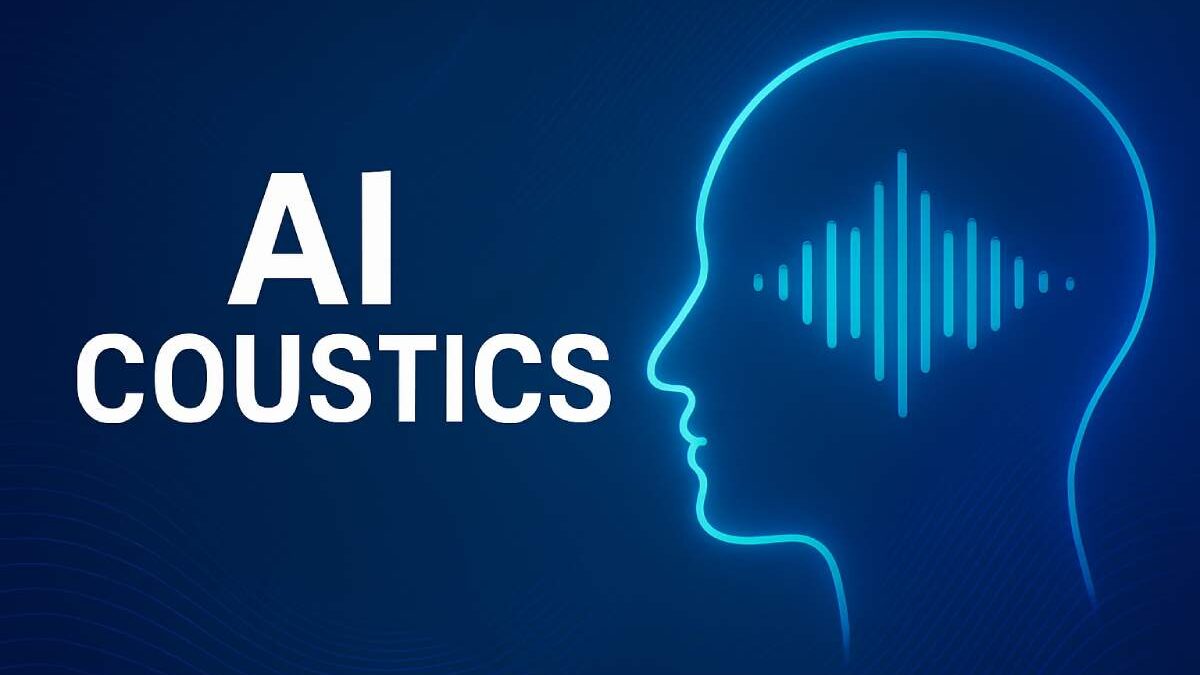Have you ever sat through a Zoom call where someone’s mic crackled like an old radio? Or maybe you’ve tried recording a podcast only to end up with more background noise than your own voice? That’s exactly the kind of real-world problem AI coustics is stepping in to fix.
Sound has always been tricky. Unlike text or images, audio can be unpredictable—cars honking, fans buzzing, dogs barking. But thanks to artificial intelligence, the game is shifting. AI coustics is all about using machine learning and advanced algorithms to clean, enhance, and even recreate sound so it feels natural, immersive, and noise-free.
Table of Contents
What Is AI Coustics, Really?
Let’s skip the textbook jargon. AI coustics is basically the blend of AI (artificial intelligence) + acoustics (the science of sound). It’s the tech that makes audio sharper, clearer, and more natural by teaching machines to “listen” like we do.
Here’s where you see it in action:
- Video calls: Background noise magically disappears.
- Music apps: Personalized sound tuning for your earbuds.
- Gaming and VR: Realistic 3D sound that makes you feel like you’re inside the world.
- Podcasts/recordings: Auto-enhanced voice clarity without spending hours editing.
Think of it as Photoshop, but for sound.
Why Does AI Coustics Matter?
Okay, but do we really need AI messing with our audio? Short answer: yes. Here’s why:
- Noise pollution is real: We’re constantly surrounded by unwanted sound. AI coustics helps us filter out the junk.
- Remote work isn’t going anywhere: Clear communication matters. Nobody has patience for muffled voices on a team call.
- Entertainment feels richer: Whether you’re binging Netflix, gaming, or vibing to music, it makes the experience more immersive.
- Accessibility gets a boost: For people with hearing challenges, It can adjust frequencies and improve clarity.
So it’s not just about “better sound quality.” It’s about making daily life smoother, whether you’re working, creating, or relaxing.
How Does AI Coustics Actually Work?
I’ll keep it simple. The tech behind AI coustics usually involves:
- Noise Reduction – AI identifies background sounds (like fans, typing, traffic) and reduces them without cutting off your voice.
- Voice Enhancement – Your speech gets a natural lift so it’s clearer and crisper.
- Spatial Audio – Sounds are placed in a 3D space so you can feel where they’re coming from.
- Personalization – The system adapts audio to your device, environment, or even your ear shape.
It’s like giving machines the ability to not just hear but understand what sound should actually feel like.
Where You’re Already Using AI Coustics (Without Realizing)
You don’t have to be a tech nerd to know this—it’s already in your pocket. Some examples:
- Apple AirPods – Adaptive noise cancellation and spatial audio.
- Zoom/Teams/Google Meet – Background noise suppression.
- Spotify/YouTube Music – AI-driven sound enhancements and auto-EQ.
- Gaming consoles + VR headsets – Immersive surround sound powered by AI models.
If you’ve ever thought, “Wow, this sounds way better than before,” chances are, AI coustics was working quietly in the background.
The Future of AI Coustics
Here’s where it gets exciting. Imagine:
- Virtual concerts where you hear music like you’re standing in the front row, even if you’re on your couch.
- Hearing aids powered by coustics that adjust in real time to your surroundings.
- 3D audio tours for travel, education, or museums where the sound feels real and dynamic.
- Content creators cutting production time in half because AI handles the sound editing.
We’re heading into a world where sound isn’t just background—it’s a fully optimized experience.
Tips If You’re Creating Content with AI Coustics
If you’re a podcaster, YouTuber, or even just someone working remotely, here’s how you can take advantage of this tech:
- Use apps with built-in AI audio tools (Krisp, Descript, Adobe Podcast).
- Test noise cancellation on your meetings—it’s usually just a setting away.
- Play with spatial audio if you’re into gaming or VR.
- Stay updated because AI coustics tools are evolving fast, and new features drop every few months.
Final Thoughts on AI Coustics
At the end of the day, sound is one of those things we don’t always notice—until it’s bad. That’s why AI coustics is such a big deal. It’s making everyday audio clearer, entertainment richer, and communication smoother.
From podcasts to video calls to gaming, Coustics is slowly becoming part of our daily lives. And trust me, once you experience truly optimized audio, it’s hard to go back to the crackly, noisy mess we used to put up with.
So the next time you hop on a call or plug in your headphones, remember—AI coustics is probably working behind the scenes to make sure what you hear is the best version possible.

